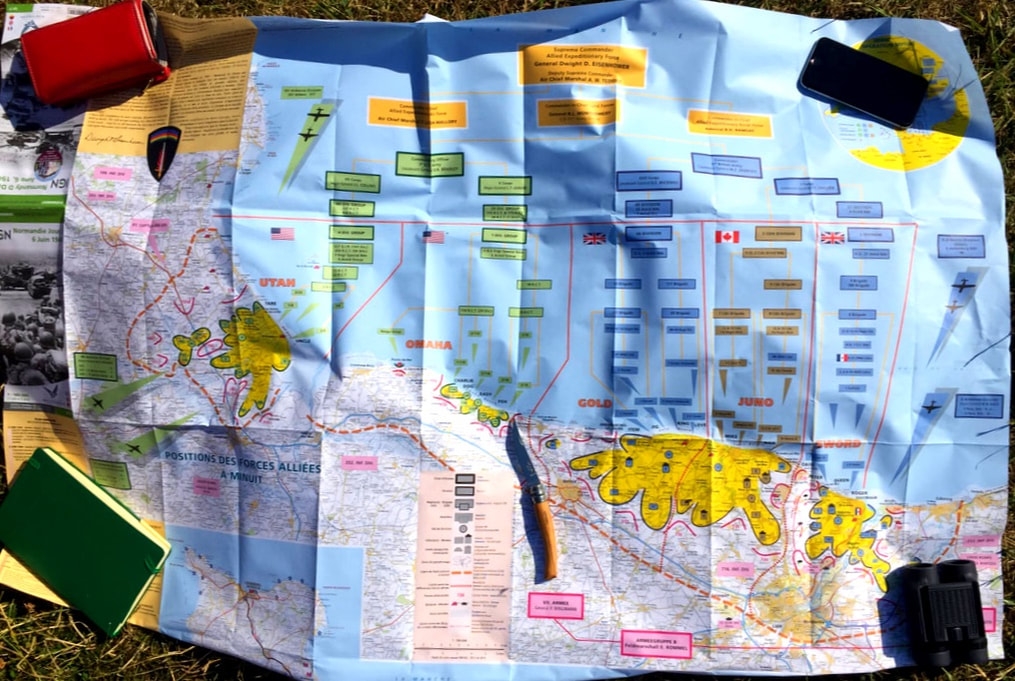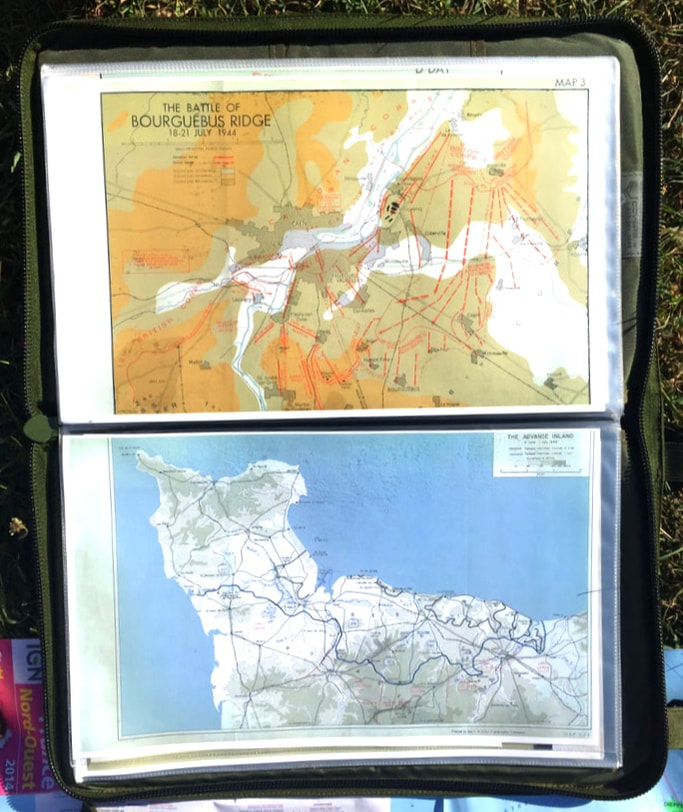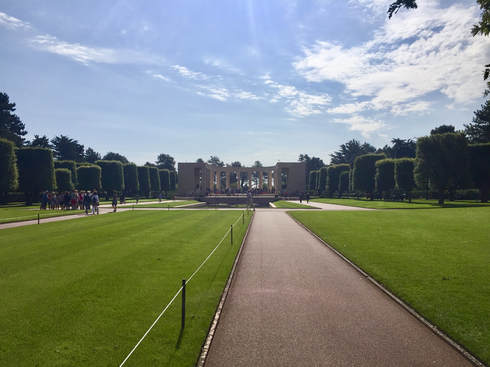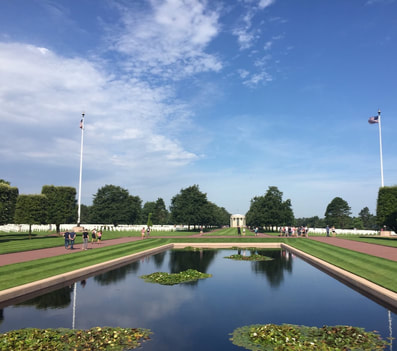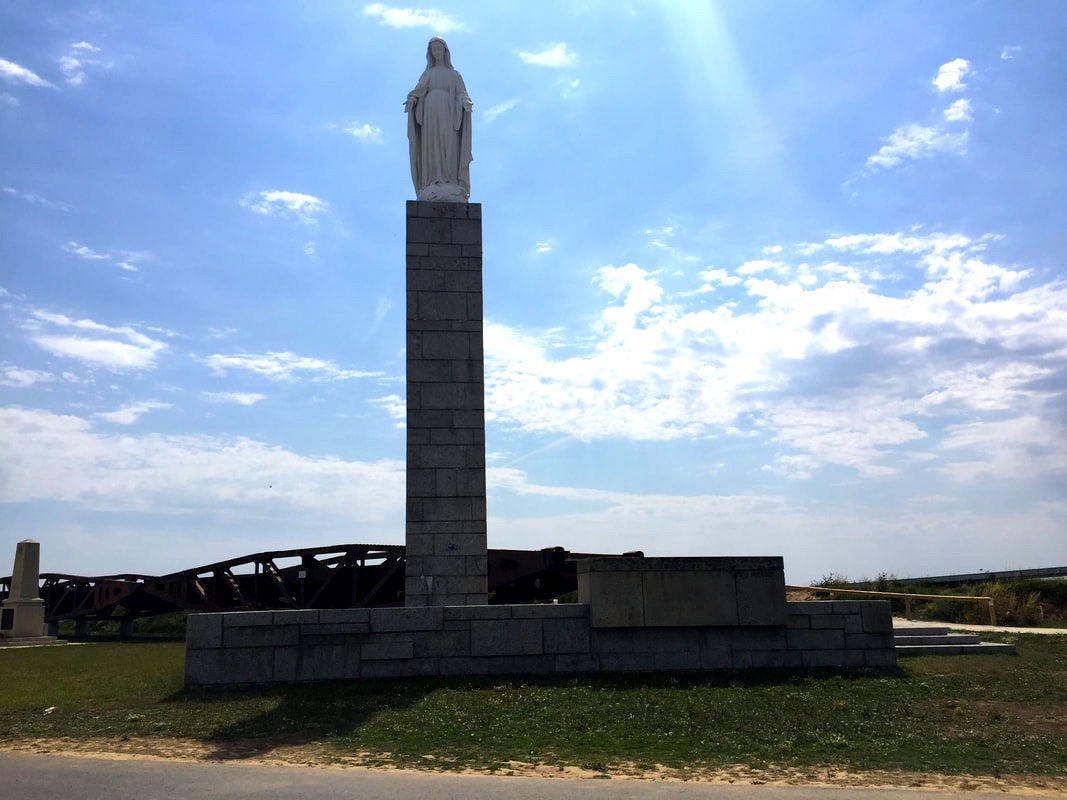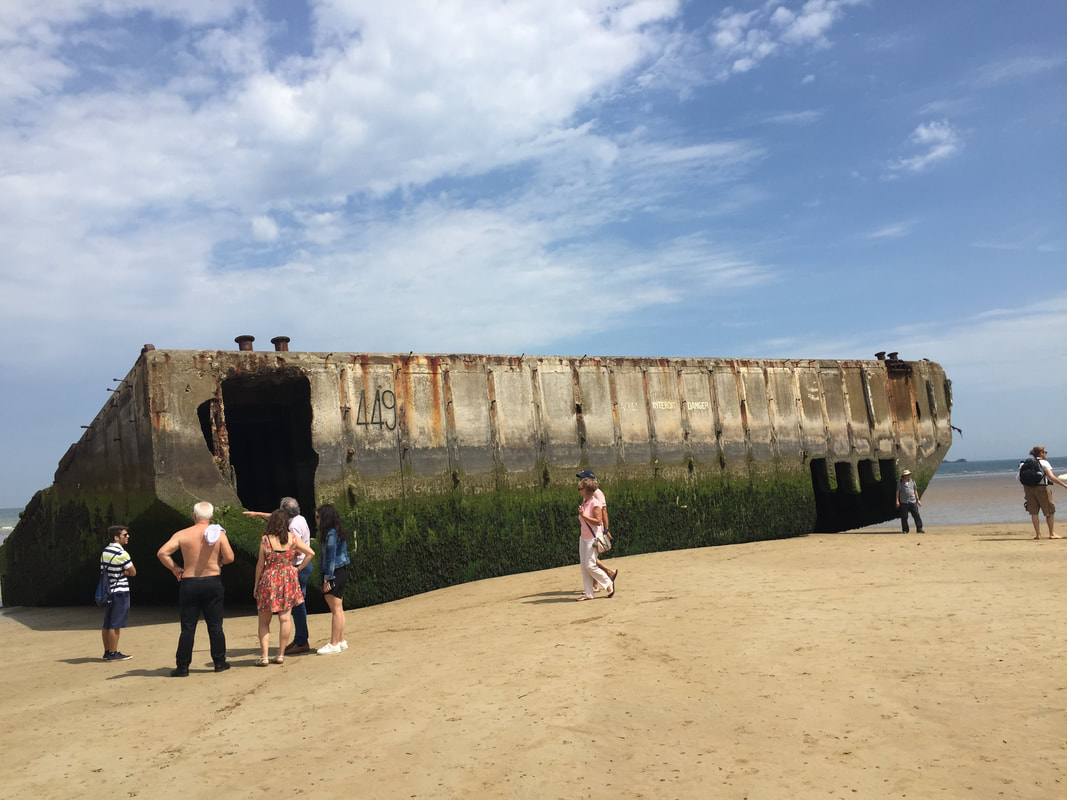"It's okay to be uncomfortable and to need to take time to fully understand."
Today's Itinerary and Activities
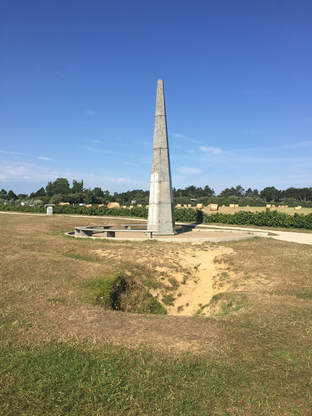 Located a short distance from the American cemetery and above Omaha Beach, the Memorial Obelisk commemorates the 1st US Infantry Division
Located a short distance from the American cemetery and above Omaha Beach, the Memorial Obelisk commemorates the 1st US Infantry Division
Today we continued work on the inquiry-based project that we began yesterday. While interrogating sites, syndicate members worked collaboratively to determine what Big Ideas and Powerful Questions to include in their operational plans.
We began the day in the American sector of the D-Day invasion. Before syndicates dispersed to explore Omaha Beach and the Normandy American Cemetery and Memorial, we considered different aspects of maps.
Following our investigation of Omaha Beach and our interrogation of the American memorial site, we drove to Arromanches, which is located in the British sector of the D-Day invasion. We spent about two hours in Arromanches enjoying the local cuisine and investigating the remnants of D-Day, including the famous artificial "Mulberry Harbour."
Our final structured activity of the day was Emily's seminar, which focused on battles and the effects of the Normandy Campaign on France's identity.
Before returning to the Moulin Morin, we had the opportunity to shop in Bayeux and visit the Tapisserie de Bayeux (Bayeux Tapestry), which is among UNESCO's memories of the world.
When we returned to the Moulin Morin, syndicates worked to complete their operational plans, which they will be presenting tomorrow morning.
We began the day in the American sector of the D-Day invasion. Before syndicates dispersed to explore Omaha Beach and the Normandy American Cemetery and Memorial, we considered different aspects of maps.
Following our investigation of Omaha Beach and our interrogation of the American memorial site, we drove to Arromanches, which is located in the British sector of the D-Day invasion. We spent about two hours in Arromanches enjoying the local cuisine and investigating the remnants of D-Day, including the famous artificial "Mulberry Harbour."
Our final structured activity of the day was Emily's seminar, which focused on battles and the effects of the Normandy Campaign on France's identity.
Before returning to the Moulin Morin, we had the opportunity to shop in Bayeux and visit the Tapisserie de Bayeux (Bayeux Tapestry), which is among UNESCO's memories of the world.
When we returned to the Moulin Morin, syndicates worked to complete their operational plans, which they will be presenting tomorrow morning.
Map Analysis
When we arrived at Colleville-sur-Mer, Lee set out multiple maps of Normandy. He then posed the following questions:
- Why are maps' edges where they are?
- Why are certain elements included and excluded on maps?
Saving Private Ryan
Blake explained that scenes from Steven Spielberg's Saving Private Ryan can be used as vehicles to further students' inquiry learning. He advised us of two specific scenes, both of which can be viewed in the YouTube clips below.
|
Sergeant Horvath: That's quite a view.
Captain Miller: Yes it is. Quite a view. |
Captain Miller: Sergeant Horvath! Do you recognize where we are?
Sergeant Horvath: Right where we're supposed to be, but no one else is! Soldier: Nobody's where they're supposed to be! |
Learned Helplessness
In the classroom, learned helplessness occurs when students feel powerless. This powerlessness often leads to avoidance and feelings of failure. Blake shared that in order to prevent students from developing learned helplessness, teachers must empower their students. In other words, teachers must value their students' voice and give students the opportunity to work independently and take charge.
The Normandy American Cemetery and Memorial
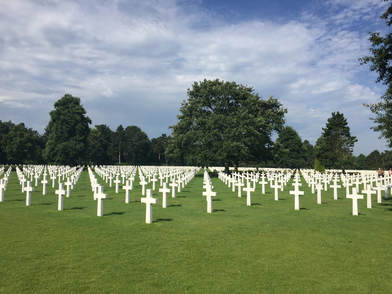 The American Cemetery in Normandy consists of rows of white crosses
The American Cemetery in Normandy consists of rows of white crosses
The Normandy American Cemetery and Memorial is located at Colleville-sur-Mer. It replaced the temporary American St. Laurent Cemetery that was developed there in 1944 immediately following the D-Day invasion. According to the American Battle Monuments Commission's website, "[t]he memorial consists of a semicircular colonnade with a loggia at each end containing large maps and narratives of the military operations; at the center is the bronze statue, 'Spirit of American Youth Rising from the Waves.' An orientation table overlooking the beach depicts the landings in Normandy. Facing west at the memorial, one sees in the foreground the reflecting pool; beyond is the burial area with a circular chapel and, at the far end, granite statues representing the United States and France."
Andrew and Riley shared their experiences while visiting the Normandy American Cemetery and Memorial:
Andrew and Riley shared their experiences while visiting the Normandy American Cemetery and Memorial:
- Andrew: "The cemetery at Omaha Beach was very different than all of the other cemeteries that we have visited. The American cemetery was much more over-the-top. It was privately funded, which is evident in the feeling and impression that it gave off. The cemetery was much more strict and formal and much less peaceful than the other cemeteries that we have visited."
- Riley: "In many ways, the cemetery at Omaha Beach reflects my stereotypes of America. (I do not mean this in a disparaging way.) The cemetery is impressive, exceptionally clean and well-maintained, and deeply patriotic. The number of visitors (and staff!) onsite reflects the importance of the site to Americans. The design is significantly different than the design of the numerous Commonwealth cemeteries that we have visited."
Arromanches
|
Arromanches is located at Gold Beach, which is where the British troops landed on D-Day. Arromanches houses the "Mulberry Harbour," a man-made harbour that allowed the Allies to unload troops and supplies onto the Normandy beaches during the Battle of Normandy.
Arromanches is the closest that we were able to get to Canada's land battle. When we arrived at Arromanches, we dispersed for lunch. We also spent time looking at evidence of the D-Day invasion including the remains of "Mulberry Harbour." For a brief summary of the significance of this harbour, please watch the YouTube video to the right. |
This is a short video about "Mulberry Harbour."
|
Is it necessary for Canadian students to learn about other nations' experiences on D-Day?
Blake asked us to consider whether it is necessary for Canadian students to study the American (and British) troops' experiences on D-Day. Zakk shared his thoughts:
- Zakk: "The Americans’ landing at Omaha Beach during the events of Operation Neptune is typically regarded as having been the most devastating victory on that day. When and why the Americans landed there can only be understood by its existence as one piece in a far more complex, international effort to establish a beachhead at Normandy. Lessons learned at Dieppe almost two years prior demonstrated that the Atlantic wall was aptly named, as breaking through it would require overwhelming force, careful consideration, and no small amount of luck. Even though the topography at Omaha resembled that at Dieppe (e.g. high ground for superb enemy observation and canalizing ground that forced Americans to attack in enfilade), Normandy—as the location for an amphibious- and air-borne, combined Allied offensive—was chosen wisely. Moreover, teaching Canadian students about American battles, and indeed any such foreign struggle, may help students to think more abstractly, specifically about international perspectives and multilateral relationships within history."
Seminar
Before leaving Arromanches, Emily conducted a seminar. After posing the questions below, she facilitated a large-group discussion.
- How and why do we assign certain battles to certain countries?
- Why do we (Canadians) "have" Juno Beach and Americans "have" Gold Beach and Omaha Beach?
- How has the Battle of Normandy affected the French?
Gallery
Where we are |
Contact Us |

